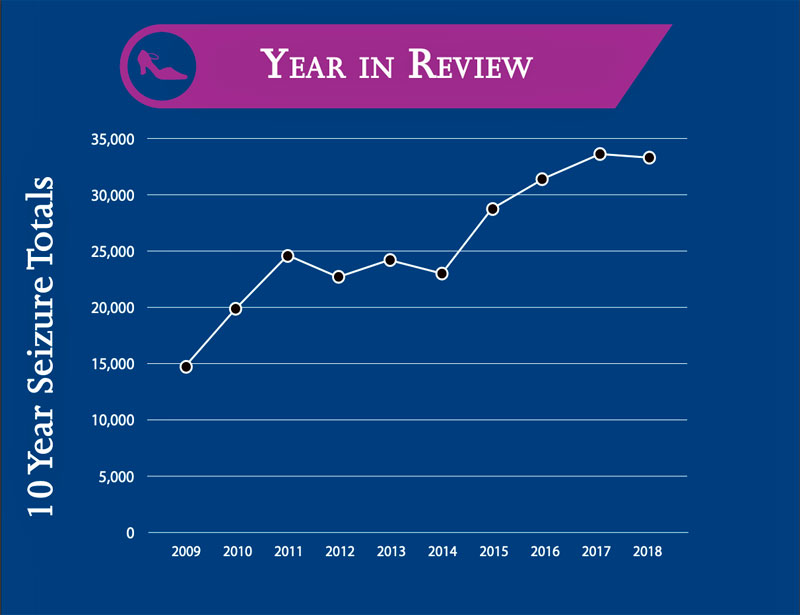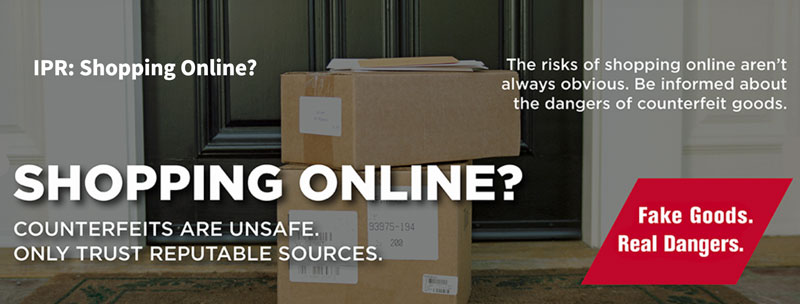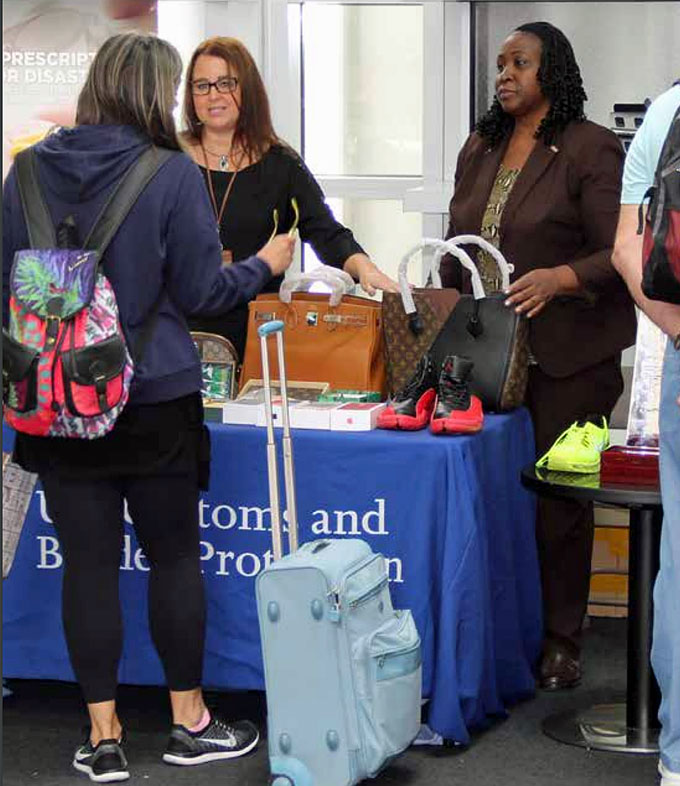
The National Intellectual Property Rights Coordination Center (IPR Center) is reviewing an annual report on the number of IPR seizures which has raised the total estimated manufacturer’s suggested retail price (MSRP) of the seized goods, had they been genuine, to $1.4 billion.
The total is based on data gathered jointly between the ICE Homeland Security Investigations-led IPR Center and Customs and Border Protection (CBP) Office of Trade in a 36-page report titled Fiscal Year 2018 Seizure Statistics.
The report also reveals an upward trend in all categories of HSI enforcement showing 381 individuals arrested, 296 indictments obtained, and 260 convictions related to intellectual property crimes.
(See a brief overview of how U.S. Customs and Border Protection protects the intellectual property rights of U.S. companies. Through targeting, inspections, examinations and policy, CBP facilitates the flow of legitimate foreign products into the U.S. while detecting illegal shipments and deterring importers and exporters from sending bogus merchandise to the U.S. Courtesy of U.S. Customs and Border Protection and YouTube. Posted on May 21, 2014.)
“This report clearly shows the ongoing threat of counterfeit goods that makes a compelling case for stepping up efforts to inform and educate the public about the risks counterfeit goods pose to public health and safety,” explained IPR Center Director Steve Francis.

“In addition to potential health and safety hazards, counterfeit goods threaten the U.S. economy, and fund organizations involved in violent crime, not only here in the United States, but around the world.”
Director Francis is taking his concerns to private industry with a request to join him and the Center’s network of 25 domestic and international partner agencies as part of a campaign designed to heighten public awareness about the dangers of counterfeit goods.
He is asking industry to help raise awareness about the threat against a wide variety businesses and organizations around the world that are engaged in the fight against counterfeits.
(Everyday, customs agents from the Department of Homeland Security stop $4.7 million worth of counterfeit products from entering the U.S. But, knockoff products continue to find their way into the marketplace. CBS News looks into the problem and shares some tips to avoid buying bogus brands. Courtesy of CBS News and YouTube. Posted on Dec 19, 2014.)
“We are using this opportunity to team up with business and industry to send a strong message to the public that infringing on property rights is not only illegal, but also unhealthy and unsafe,” Francis added.
“More importantly, we want to educate consumers about the harm associated with counterfeits to aid in our efforts to identify and investigate individuals or companies suspected of engaging in the manufacture, shipment, distribution and sale of counterfeit goods.”
The outreach efforts are part of the HSI-led IPR Center’s strategy to engage in partnerships with the public and private sectors to combat IP theft through Operation Joint Venture.
(Learn More. Courtesy of FBI IPR and YouTube. Posted on Dec 14, 2017.)
This initiative is designed to increase information sharing with public and private sectors to combat the illegal importation and distribution of counterfeit, substandard and tainted goods.
In FY 2018, more than 16,000 people participated in more than 300 outreach and training events.
In the last two years, these efforts have reached more than 30,000 stakeholders.

The dangers of buying counterfeit products aren’t always obvious.
There are economic impacts, legal implications, and health and safety risks that are important for you to know before you buy.
When traveling, buy from reputable sources.
Economic Impacts
-
Each year, CBP seizes all kinds of counterfeit products from all over the world.
-
Counterfeiters look to make profits by making fake versions of the hottest products as soon they are available on the market.
-
Each time you buy a counterfeit good, a legitimate company loses revenue.
-
This translates to lost profits and U.S. jobs over time.
-
Know who you buy from.

Health and Safety
-
Counterfeiters don’t care about your well-being. They just want to make a profit.
-
Many counterfeit products are low-quality and can cause injuries.
-
Last year, CBP seized more items that pose health and safety risks than ever before.
-
The top three categories were personal care, pharmaceuticals, and consumer electronics. Protect yourself and your family by avoiding potentially risky items.
Legal Implications
-
It is illegal to purchase counterfeit goods.
-
Bringing them into the United States may result in civil or criminal penalties.
-
Purchasing counterfeit goods supports criminal activities such as money laundering and trafficking in illegal guns and drugs.
-
Remember, if it seems like a steal, it is.

E-Commerce
-
E-Commerce is a growing segment of the U.S. economy and has been increasing significantly for the past several years.
-
Consumer habits are changing as the internet allows individuals to make purchases online.
-
These advances in economic activity have led to increasing volumes of imports of small, just-in-time packages, creating inspection challenges for CBP.
-
E-Commerce shipments pose the same health, safety, and economic security risks as containerized shipments, but the volume is higher and continues to grow.
-
Additionally, transnational criminal organizations are shipping illicit goods to the United States via small packages due to a perceived lower interdiction risk and less severe consequences if the package is interdicted.
Here are some additional highlights of the Fiscal Year 2018 Seizure Statistics Report:

-
e-Commerce sales, including those through third-party platforms, have resulted in a sharp increase in the shipment of small packages into the United States.
-
In FY 2018, there were 161 million express shipments, and 475 million packages shipped through the international mail environment.
-
Over 90% of all intellectual property seizures occur in the international mail and express environments.
-
-
CBP and HSI seized 213 shipments of computer networking equipment affixed with counterfeit trademarks with a total MSRP value of nearly $15.5 million.
-
This is a 25% increase in the number of seizures of computer networking equipment, and a 112% increase in MSRP value over FY 2017.
-
The networking equipment seizures violated a total of seven trademarks recorded with CBP and occurred at 21 ports around the country.
-
-
Each year, more than 11 million maritime containers arrive at seaports.
-
At land borders, another 10 million arrive by truck, and three million arrive by rail.
-
An additional quarter billion more cargo, postal, and express consignment packages arrive through air travel.
-
-
The Department of Homeland Security (DHS) remains vigilant in targeting shipments containing IPR-infringing goods, levying civil fines and criminally investigating those who seek to violate trade laws, harm consumers, and damage our economy.
(Customs officers are working to stop huge quantities of counterfeit products from ending up in your holiday shopping cart. CBS This Morning visited a facility in New Jersey to see who profits from the illegal goods. Courtesy of CBS This Morning and YouTube. Posted on Dec 19, 2016.)
The report lists the top five product categories as apparel/accessories, footwear, watches/jewelry, handbags/wallets, and consumer electronics.
Watches and jewelry accounted for 44% of the total $1.4 billion MSRP, while handbags and wallets represented 16% of the total.
In August, U.S. Customs and Border Protection (CBP) officers assigned to Cargo Operations at Los Angeles International Airport (LAX) in coordination with the Import Specialist assigned to the impacted Centers, seized 5,300 counterfeit products.
If genuine, the seized merchandise would have had an estimated manufacturer’s suggested retail price of $3,475,000.
Among the seized products were:
-
1,242 counterfeit Gucci belts
-
678 pairs of counterfeit Nike shoes
-
531 counterfeit Louis Vuitton handbags
-
500 counterfeit Samsung adaptors
-
502 counterfeit Gucci fanny packs
-
230 counterfeit Hermes handbags
-
192 counterfeit Casio Shock watches
-
144 counterfeit Ferragamo belts
-
100 counterfeit Versace belts, and
-
119 counterfeit Fendi shorts

“CBP protects businesses and consumers every day through an aggressive intellectual property rights enforcement program,” explained Carlos C. Martel, CBP Director of Field Operations in Los Angeles.
“These seizures demonstrate the high level of skill and vigilance of our officers and import specialists.”
The merchandise arrived at LAX via air cargo from Hong Kong.
The quantity and value of counterfeit merchandise seized is a clear indication of the profits that are involved in the illegal trade of luxury goods.
“The American public should be aware that buying a counterfeit product is a lose-lose proposition, because the money they paid often funds criminal enterprises,” said Donald R. Kusser, CBP Port Director at LAX.
“In addition, buyers get a substandard low-quality product, containing unknown chemicals and likely produced under inhumane conditions.”
Available on illegitimate websites and sold in underground outlets, counterfeit high fashion commodities multiply the illegal profits of smugglers and traffickers.

Consumers are tricked into believing they are buying an original product at a significant discount, and the money they spend on these types of goods is often used in other forms of criminal enterprises.
In fiscal year (FY) 2018, CBP seized 33,810 shipments containing goods that violated intellectual property rights.
The total estimated manufacturer’s suggested retail price (MSRP) of the seized goods, had they been genuine, increased to nearly $1.4 billion from over $1.2 billion in FY 2017.
Wearing apparel and accessories once again topped the list for number of seizures with 6,098, representing 18 percent of all seizures.
Watches and jewelry continued as the top product seized by total MSRP value with seizures valued at over $618 million, representing 44 percent of the total.
Handbags and wallets were second with seizures estimated to be valued at more than $226 million.
Have you been affected by counterfeit goods?
If you have any suspicion of or information regarding suspected fraud or illegal trade activity, please report the trade violation to e-Allegations Online Trade Violation Reporting System or by calling 1-800-BE-ALERT.
For more information on the Fiscal Year 2018 Seizure Statistics report, please visit www.iprcenter.gov.
To Learn More about the dangers of counterfeiting and how to work with CBP, see our Intellectual Property Rights Enforcement webpage.
Also, view CBP’s 2017 IPR seizure statistics.
(Learn More. Courtesy of FBI IPR and YouTube. Posted on Dec 14, 2017.)
















